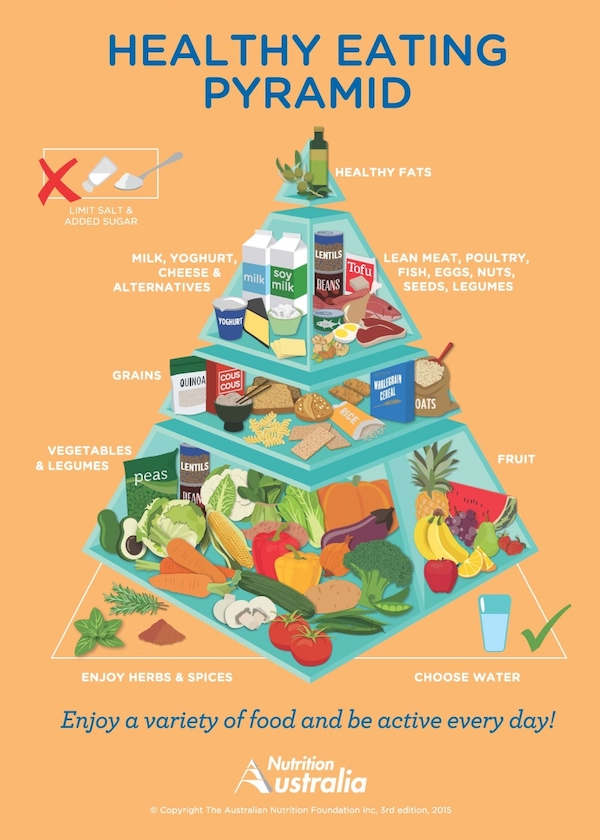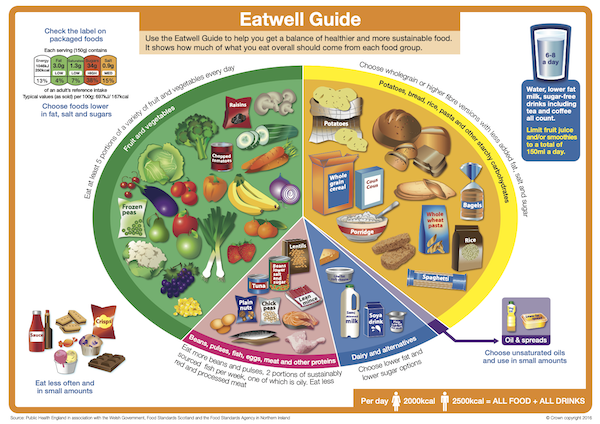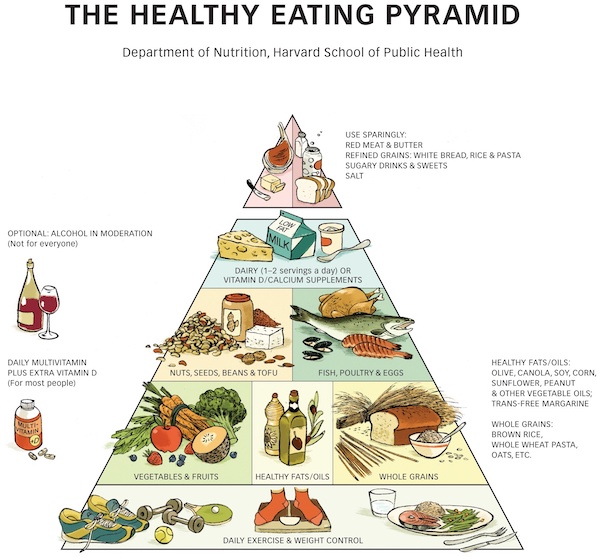National healthy diet and eating guidelines aren’t sexy. They don’t promise a beach-ready bikini body, or a six-pack in 30 days. But they do work in helping you sustain a healthy body and lifestyle. You probably already know there is a lot of misleading information out there (Instagram influencers, I’m looking at you!)
Today, I’m going to break down the essential things you need to know about structuring a healthy diet. Below you’ll find out what you need to include and strategies to make the most of your available food choices.
General principles of a healthy diet
Before delving into specifics, let’s look at what constitutes a ‘well-balanced’ diet.
Despite multiple diet books claiming the contrary, national nutrition guidelines are accepted by leading scientists and nutritionists as a sound basis for a healthy diet. They highlight grains, fruits and vegetables as the starting point for a nutritious diet.
They look slightly different, but the concepts are generally the same. Here are the national food guidelines for Australia, UK and USA.
Australia’s Healthy Eating Pyramid

The UKs Healthy Eating Guidelines from the NHS

The USA’s National Nutrition Guidelines

In general, the healthy diet principles are the same. We’ll look at the main tiers and sections and what you need to know about them.
Fruits and Vegetables
The first tier stresses the need for a generous intake of fruit and veg. This can take some getting used to. However, there are a few tips that can help you achieve the recommended intake:
Use chopped or dried fruits as a topping on breakfast cereals instead of sugar.
Have a piece of fruit for pudding instead of sweetened sugary foods.
When preparing a salad, remember that virtually any raw vegetable can be used. Not just lettuce, tomato and cucumber!
Learn how to make a decent salad dressing. Mix a quarter teaspoon of salt, a sprinkling of black pepper, a dessertspoon of vinegar, two dessertspoons of olive oil and the juice from half a lemon together, pour over the chopped vegetables, toss and serve.
Try eating a salad before your main meal. If you are unused to eating salads, this is a good way to develop the habit.
Carbohydrates as part of a healthy diet
The next layer emphasises unrefined carbohydrates, so here are some tips for making sure you’re eating the right sort.
Always choose ‘wholemeal’ bread, which contains up to 10 times the essential health-giving nutrients slice for slice over other bread.
Avoid bread described as ‘granary’, brown or multi-grain. Nutritionally, these terms are meaningless.
Where possible, look for unrefined whole-grain breakfast cereals. For example, Weetabix, Shredded Wheat, porridge oats and muesli all fit the bill. Ensure that any cereal is free from added sugar.
Always choose wholemeal pasta over white and whole grain brown rice over white (for the same reasons as given for bread).
Use beans and lentils 2-3 times per week, either as a basis of a meal in themselves or to bulk out meat dishes. Not only are they a rich source of nutrients and fibre, but they also release their carbohydrate very gently — ideal for refuelling muscles and maintaining energy levels.
Fats, sweets and processed foods
At the top of the healthy diet pyramid are the chocoholics favourites. These foods should be kept to a minimum, but sometimes it’s easier said than done! Here then are a few tips to help you on your way:
Minimise your consumption of foods made with white flour (e.g. white bread, pastry, cakes, biscuits etc.). These are low in nutrients such as the B vitamins, magnesium and zinc.
When trying new recipes, you can often cut down on any added fat and sugar by up to 50% without impairing the taste or texture of the end result.
Avoid sugar and sugar-containing foods where possible and use them as treats only.
Always read labels when shopping — check for added sugar (anything ending in ‘ose’), salt (sodium) and fat contents.
Tips for reducing your fat intake
To lower your fat intake, opt for semi or fully skimmed milk. Likewise, choose half fat cheddar or cottage cheese. Additionally, use low-fat natural yoghurt in place of cream or mayonnaise.
For meat, you’ll generally find poultry is lower in fat than red meat sources. Furthermore, breast meat is lower in fat than leg. Whichever choices you make, buy the best quality lean cuts you can afford. Remove the skin from poultry before cooking, since that’s where most of the fat is found.
Avoid fast foods, fried foods, pre-prepared foods, biscuits, cakes, pastries, crisps, chocolate and other junk foods, which come with lots of non-essential fat already added.
Fry only occasionally, using just small quantities of olive oil.
Remember though that the essential fatty acids (EFAs) are actually essential for our health. In the West, we eat too much of the non-essential, saturated and processed fats, but not enough EFAs. Eat fatty fish (mackerel, herring, trout, salmon, sardines, pilchards etc.) 1-2 times per week to boost your EFA intake. Add seeds to salads and use unsalted nuts as snacks to boost EFA intake.
Proteins
On the third level of the pyramid are the protein-rich foods. These should only constitute around 25% of your calorie intake, but it’s still important to make sure that you get the best on offer:
Choose smaller quantities of lean cuts of meat rather than large amounts of cheap meat.
Try to include fresh fish (ocean-caught, not farmed) in your diet at least twice per week.
Remember that peas, beans and lentils are rich in protein as well as slow-releasing carbohydrates.
Include nuts and seeds in your diet. These will give you a protein and nutrient boost. Try sprinkling seeds such as sunflower and pumpkin on salads. Use unsalted nuts mixed with raisins as a healthy snack.
Milk, yoghurt and cheese are not only protein-rich but a great source of calcium too. Unless you’re sure you are allergic to milk products, it’s a good idea to include some milk produce regularly in your diet.
Anything more to add to this basic healthy diet guide?
Is there a tip you particularly liked? How healthy is your diet at the moment? Perhaps there’s something you’re still unsure of. Let me know in the comments below and I’ll get back to you.
READ ALSO: Ready Made Meals | Looking at the Pros and Cons of Prepackaged Food
